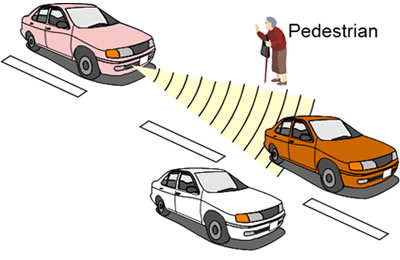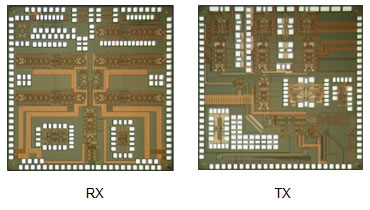- News
17 October 2014
Fujitsu develops lower-cost CMOS-based automotive millimeter-wave radar
At the 44th European Microwave Conference (EuMC 2014) in Rome, Italy (6-9 October), Fujitsu Laboratories of Kawasaki, Japan reported that it has produced a transceiver chip for millimeter-wave radar in a complementary metal-oxide-semiconductor (CMOS) implementation, enabling costs to be reduced while boosting the short-range detection performance of the transceiver.
Existing millimeter-wave radar uses silicon-germanium (SiGe) transceiver chips. Using CMOS silicon would allow for lower costs and lower power consumption than SiGe, but it is more susceptible to noise, particularly in lower frequency ranges, which has made the use of CMOS for millimeter-wave radar impractical to date.
Fujitsu Laboratories says that it has succeeded in producing a prototype CMOS transceiver chip that suppresses oscillator noise on the receiver circuit by configuring a frequency-conversion circuit so that it is compatible with the 76-81GHz band used in automotive millimeter-wave radar. This greatly reduces noise levels found in previously attempted CMOS transceivers, resulting in performance equivalent to or better than current SiGe chips, it is claimed. The technology enables power consumption of CMOS-based millimeter-wave radar to be approximately halved compared SiGe chips, and at lower costs.
 Picture: Figure 1: Detecting nearby cars and pedestrians with millimeter-wave radar.
Picture: Figure 1: Detecting nearby cars and pedestrians with millimeter-wave radar.
To make driving safer, cars are increasingly being equipped with technologies that can detect obstacles nearby and even control the brakes or accelerator in response. Technologies used for obstacle-detection include millimeter-wave radar, LiDAR and stereoscopic cameras. Compared to LiDAR and stereoscopic cameras (which both use visible wavelengths of light), millimeter-wave radar is relatively unaffected by rain, fog and reflections, giving it an important role as an onboard sensor. The value that such sensors bring to cars creates an impetus to develop technologies for implementing these sensors at lower costs, says Fujitsu.
Millimeter-wave radar operates using high frequencies in the 76-81GHz range, and hence has required special SiGe bipolar transistors. However, advances in semiconductor technology have begun to make it possible to implement millimeter-wave circuits in inexpensive CMOS technology (most commonly used for digital circuits). Compared to conventional bipolar SiGe transistors, CMOS can run on lower-voltage power supplies, so it consumes less power and, although it performs roughly the same in the millimeter-wave range, it had been more adversely affected by noise in the low-frequency range. In millimeter-wave radar, a signal from an oscillator is transmitted, the signal is reflected back from obstacles and is received, and the two are compared to determine the distance, speed and direction of the obstacle. Detection of nearby pedestrians and objects that have weak reflectance is especially problematic (Figure 1). To improve detection of nearby pedestrians, it was therefore essential to reduce low-frequency noise.
To ensure good detection performance at short distances with CMOS-based millimeter-wave radar requires a solution to the low-frequency noise problem. The technology developed by Fujitsu Laboratories hence has the following two key features:
- ensuring good high-frequency performance in the receiver chip while reducing low-frequency noise;
- consuming half the power of existing bipolar SiGe transistors.
Fujitsu Laboratories used a double-balanced resistive mixer in the receiver’s frequency-conversion circuit, which takes the frequency difference (IF signal) that occurs from signals reflecting from objects (RF signals) and local oscillator signals (LO signals). A resistive mixer is a circuit format that can recover IF signals through electricity from LO signals without having to apply power supply voltage so the flow of DC current to a mixer transistor can be kept to a minimum, which avoids the increase in low-frequency noise.
Also, using a double-balanced construction which synthesizes the differential motion of the resistive mixer, noise increase from DC offset that occurs via LO signals input to the mixer can be reduced. It also has the effect of reducing noise below 10kHz while maintaining high-frequency characteristics.
Fujitsu Laboratories produced a prototype 4-channel receiver chip using this circuit, with functionality equivalent to current SiGe products, along with a prototype transmitter chip that used a phase-locked loop (PLL) synthesizer with low phase noise that the firm announced last year (Figure 2).
 Figure 2: New CMOS receiver chip (RX) and transmitter chip (TX).
Figure 2: New CMOS receiver chip (RX) and transmitter chip (TX).
All told, this allowed for a millimeter-wave radar where all of the principal high-frequency circuits were produced using a 65nm CMOS process.
The SSB noise index (an indicator of the receiver chip's low-frequency noise) was 12dB for the prototype - at the same level as existing SiGe products - representing an 18dB improvement over the figure of 30dB for CMOS units previously announced at academic meetings and other sources. This improvement represents a significant reduction in noise, equivalent to approximately one-sixtieth of previous levels, says Fujitsu. Furthermore, compared with SiGe chips that run on voltages of 3-5V, the CMOS technology used here achieves equivalent performance with a 1.2V power source, approximately halving power consumption, it is reckoned.
By reducing noise in the low-frequency range, the performance of millimeter-wave radar detecting nearby objects is improved, says Fujitsu. Performance in detecting pedestrians and nearby objects is hence improved. Adapting the widely used 65nm CMOS process technology to this application promises easier, low-cost mass production, says Fujitsu. Also, with half the power requirements of SiGe bipolar transistors, the power-supply circuitry for the radar sensor can also be less expensive. Furthermore, this makes it easy to combine multiple digital circuits, for more functional millimeter-wave radar in the future, the firm concludes.
Fujitsu Laboratories currently anticipates practical applications around 2018, and plans to continue working on more functional millimeter-wave radar.
www.eumweek.com/conferences/eumc.html


